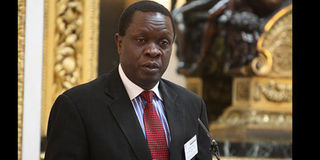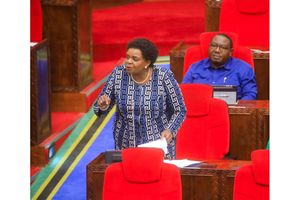Govt clarifies Sh20tr investment plan

But according to minister of Trade, Industries and Investment Charles Mwijage (pictured), the reports are credible and he says he is ready to take those doubting to the sites and show them investment plans.
What you need to know:
- But according to minister of Trade, Industries and Investment Charles Mwijage (pictured), the reports are credible and he says he is ready to take those doubting to the sites and show them investment plans. Some commentators led by former Kigoma South MP David Kafulila say $9 billion investment by three firms seems unrealistic because it is too huge.
Dar es Salaam. Reports that three cement firms— EAM, Mamba and Sungura —plan to invest at least $9 billion (Sh20 trillion), have raised doubts with some commentators, saying the amount is unrealistic for it is too much for just three companies.
But according to minister of Trade, Industries and Investment Charles Mwijage (pictured), the reports are credible and he says he is ready to take those doubting to the sites and show them investment plans. Some commentators led by former Kigoma South MP David Kafulila say $9 billion investment by three firms seems unrealistic because it is too huge.
In his comments he sent to The Citizen after the publication of the story last week over the planned cement investment, Mr Kafulila gives the example of Dangote Cement, which he says being the largest cement factory in Africa has had the total investment of $500 million (Sh1 trillion).
“The biggest investor in this industry Dangote Cement has spent only $0.5 billion. India the second world largest producer of cement, with a giant and promising economy, has FDI investments in the cement industry of less than $4 billion by 2014. I suppose Mr Mwijage was misquoted or he didn’t know what he was talking about,” Mr Kafulila said. But Mr Mwijage told The Citizen at the weekend that those, who were sceptical about it did not know what they were talking about. “Tanzanians are sceptical people… those, who doubt the figures should come to me and I will take them to the sites of the planned project. No more comments.”
Other commentators, who spoke about the investments did not doubt the figure, but expressed concern over the capacity of the Tanzanian economy to accommodate large foreign direct investments.
Former executive director of the UDSM Institute of Resource Assessment, Prof Adolph Mascaren, said policies must be there to enable the proper use of raw materials by foreign investors and for the benefit of Tanzanians. Economics Prof Haji Semboja also from UDSM gave similar views that cement reserves were huge, but could not attract corresponding investments due to lack of proper strategies on industrialisation.
“We have huge cement reserves in the country. What is lacking is a sound strategy to implement our plans and polices properly. For example, the Second Five-Year Plan, which started early this year, is too broad and requires a specific strategy of sectorial implementation,” Prof Semboja argued.
According to him, without specific and comprehensive strategy of implementing industrialisation plans, Tanzania will be caught off guard like what happened with the Dangote Cement company.
(Reported by Alex Malanga and Ludger Kasumuni)



